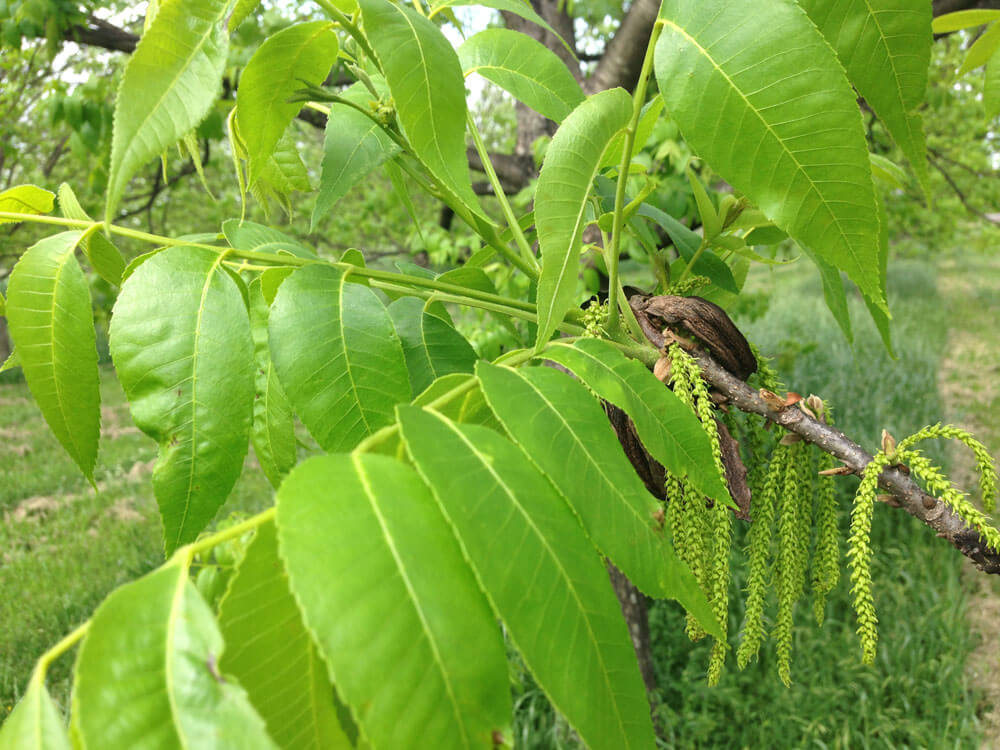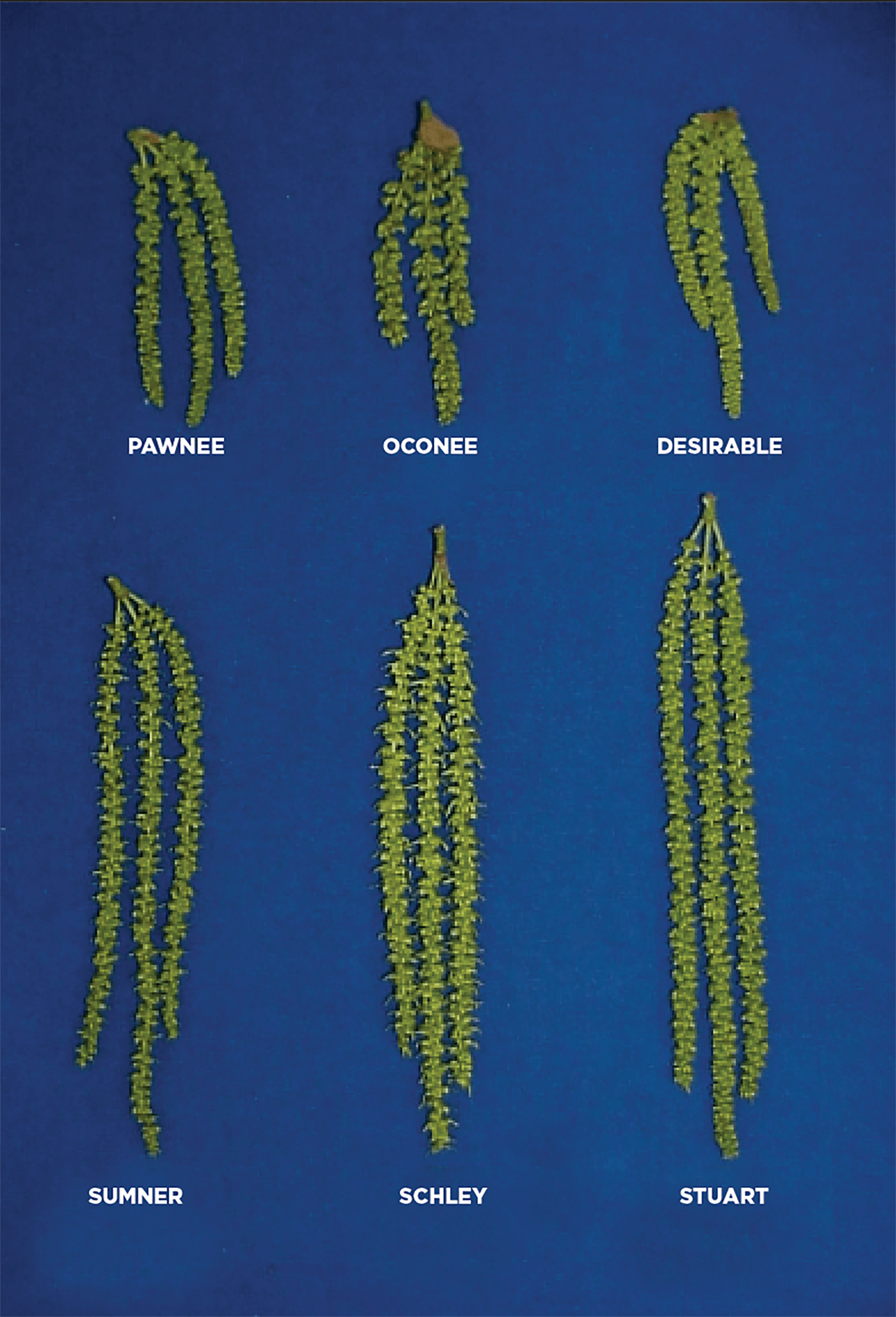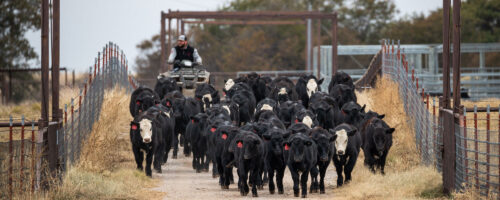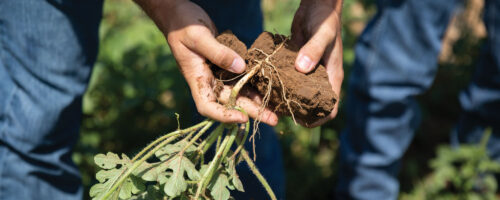A common question asked by homeowners is “Can I plant just one pecan tree in my yard or pasture?” To sufficiently answer this question, we must first discuss the dichogamy of a pecan tree and how it affects pollination.
For most horticultural plants to successfully produce a crop, viable pollen must be present when the female flowers are receptive for pollination. This is true both for bee-pollinated plants and for wind-pollinated plants, such as pecan. Adequate pollination of a pecan tree is critical for the yield and kernel quality of the nut.
Most fruit trees have flowers that are considered complete, with each flower having a pistil (female) and stamen (male) reproductive structures. However, pecans are different because they have separate male and female flowers on the same tree. They are physically located on different parts of the tree, with the female nutlets (Figure 1) emerging from current season growth, and the male catkins (Figure 1) developing on last year’s growth. But in addition to being physically separated, the male and female flowers do not mature at the same time, which is called dichogamous flowering.

If that isn’t confusing enough, pecans take it one step further. You can find some trees that mature the male flowers first followed by the maturing female flower, with this sequence being a Type I or protandrous flowering. While another tree matures the female flower first followed by the male flowers maturing, which is known as a Type II or protogynous flowering. If male pollen release does not overlap nutlet receptivity then the tree has complete dichogamy, but if the timing of pollen release does overlap nutlet receptivity then the tree has incomplete dichogamy. Protogynous cultivars typically have long, thin catkins, while protandrous cultivars typically have catkins which are shorter and of greater diameter (Figure 2).
Why do pecans have this type of flowering? The simple answer is to maximize outcrossing which increases genetic diversity in native stands. More genetic variation leads to better pecan tree survival, continued evolution, and better climate adaptation. Trees with complete dichogamy must be cross-pollinated by another tree to set fruit. Cross-pollinated pecans are usually larger and higher quality than self-pollinated pecans. Self-pollination leads to poor nut growth and development, resulting in low quality kernels and increased nut abortion.
If you look at Figure 3, you can easily see that while Kanza (Type II) is a good match for Caddo (Type I), use of another Type II pecan such as Forkert would be a poor choice as a pollinator for Kanza or Caddo. Forkert’s pollen shed occurs well after the Kanza and Caddo nutlets are receptive. Therefore, it is imperative that you consult a pecan variety pollination chart when designing a pecan orchard to ensure there will be adequate pollination. It is recommended to find at least two to three varieties that shed pollen at the same time the main variety is receptive.
Research indicates that effective pollination may decrease at distances greater than 150 feet from a pollen source, so you must have pollinator trees no further than every fourth row. The duration of pollen dehiscence (shedding) for a cultivar may vary greatly in different years, as a function of variable weather and due to location of the orchards. Sustained high winds coupled with low humidity tend to shorten the period of effective pollination, both by accelerating pollen dehiscence and by shortening the period of nutlet receptivity. High humidity delays pollen dehiscence and extends the period of nutlet receptivity, according to research published in proceedings of the National Pecan Association in 1929. Small orchards may not need pollinator treesif native or seedling trees are within a few hundred feet of the new planting; however, large commercial plantings should include pollinators within the orchard.
Long and Thin Catkins

Type I and Type II varieties
When planning an orchard, both Type I and Type II varieties need to be included to ensure pollination of all varieties.
Common Type I or protandrous pecan varieties:
- Caddo
- Cheyenne
- Creek
- Desirable
- Jackson
- Oconee
- Pawnee
- Western
Common Type II or protogynous pecan varieties include:
- Burkett
- Candy
- Choctaw
- Elliot
- Forkert
- Kanza
- Lakota
- Maramec
- Nacono
- Schley
- Stuart
- Sumner
- Wichita
However, it is not as simple as planting a random combination of protandrous and protogynous pecan varieties.
Pecan pollination chart

Literature Cited
Woodroof, J. G., and N. C. Woodroof. 1929. Flowering and fruiting habit of the pecan. Proc. National Pecan Assoc. 28:128-136.
Glossary
Anther: The pollen-bearing part of a stamen (male flower)
Catkin: The pendulous spike of multiple male (staminate) flowers
Cross-pollination: In pecan trees, when pollen is delivered from the stamen (male) flower of one tree to the female flower of another tree
Dehiscence: The opening of anthers to release pollen, or “shedding”
Dichogamous flowering: When male and female flowers on a tree mature at different times
Dichogamy: Can be complete (if male pollen release does not overlap female nutlet receptivity), or incomplete (if the timing of pollen release does overlap nutlet receptivity)
Nutlet: The mature female flower structure of the pecan tree
Pistil: The female reproductive structure of a flower
Pollinator tree: In (or near) a pecan orchard, a tree that sheds pollen when the female nutlets on the main variety of pecan trees are receptive
Protandrous (Type I): Trees on which the male flowers mature first, followed by the female flowers
Protogynous (Type II): Trees on which the female flowers mature first, followed by the male flowers
Self-pollination: The acceptance by stigmas of pollen from flowers on the same tree
Stamen: The male reproductive organ of a flower



Comment